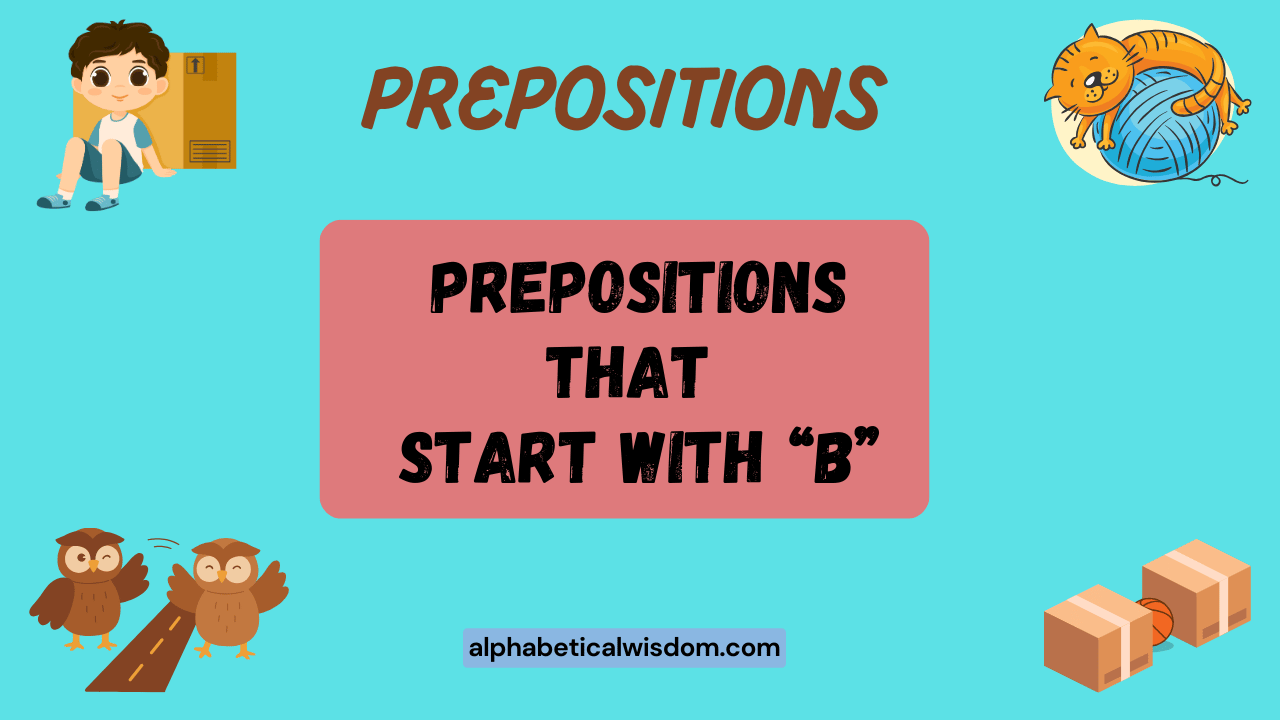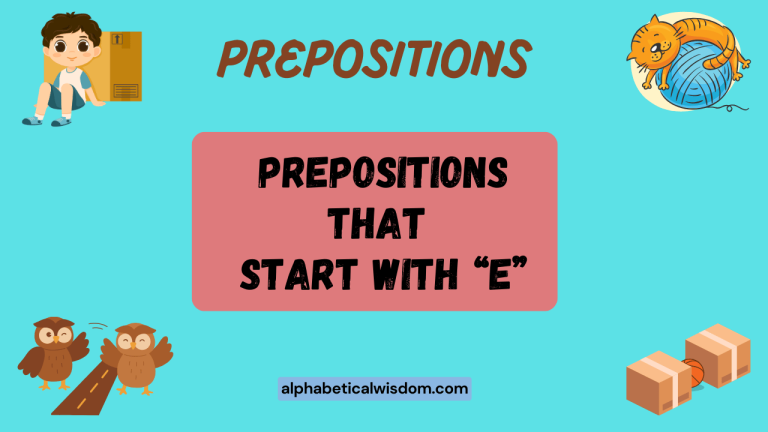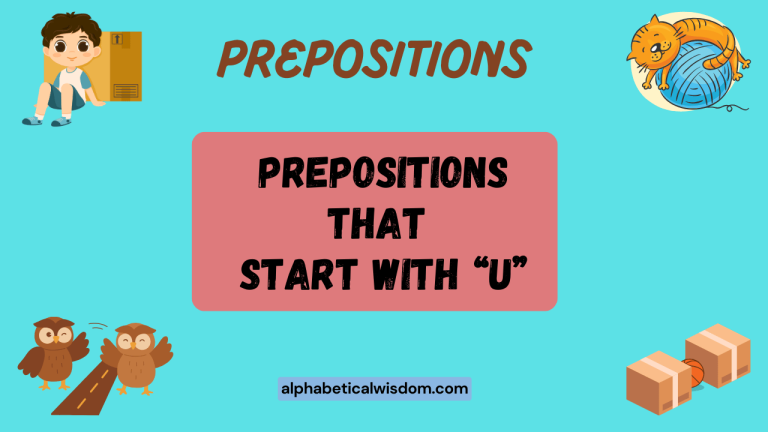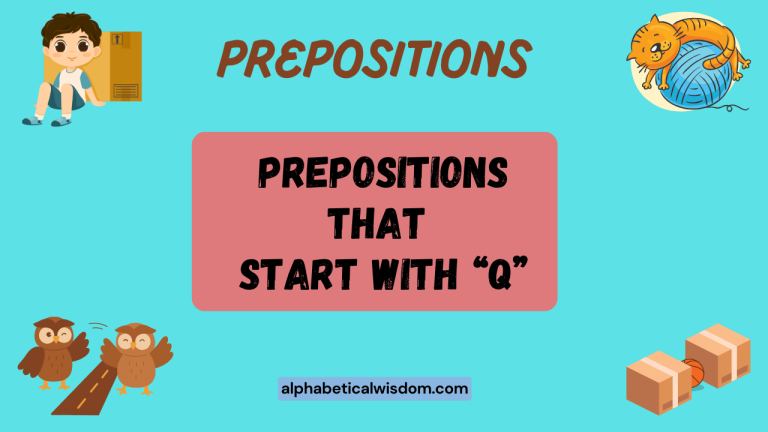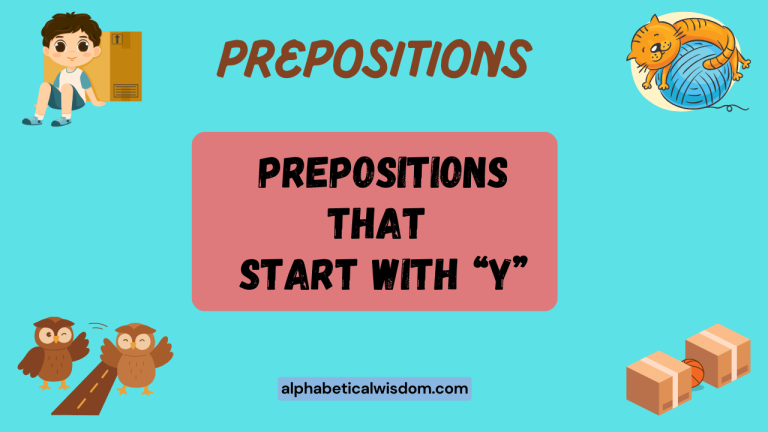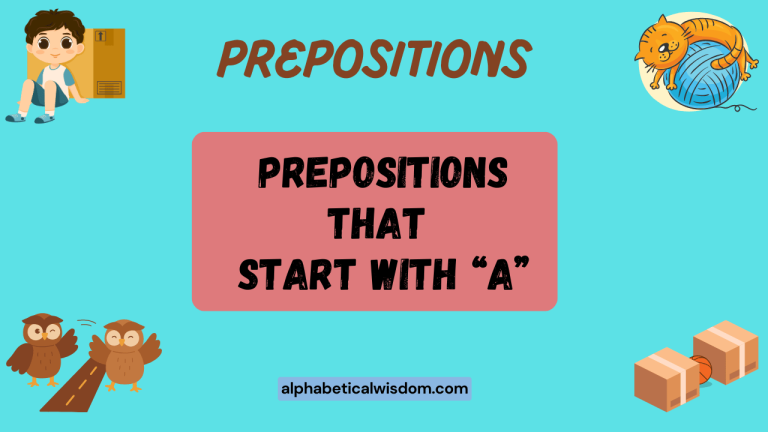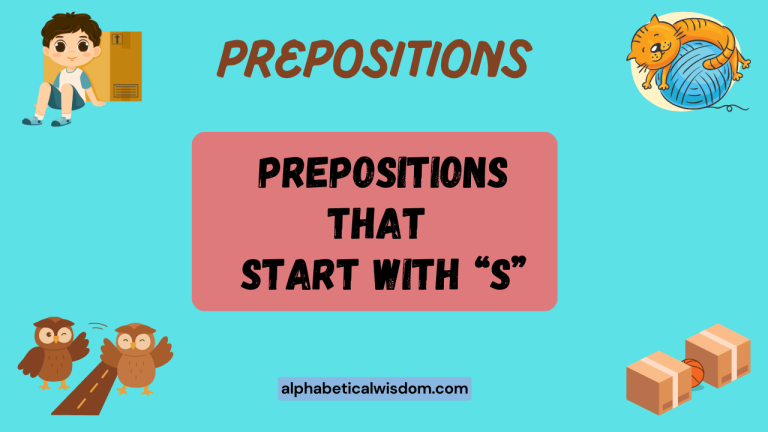Mastering Prepositions Starting With ‘B’: A Comprehensive Guide
Prepositions are essential components of the English language, acting as bridges that connect nouns, pronouns, and phrases to other parts of a sentence. Among these, prepositions that begin with the letter ‘B’ play a significant role in expressing relationships of location, time, and manner.
Understanding these prepositions is crucial for constructing clear, precise, and grammatically correct sentences. This article provides a comprehensive guide to prepositions starting with ‘B,’ offering detailed explanations, examples, and practice exercises suitable for English learners of all levels.
Whether you are a beginner aiming to grasp the basics or an advanced learner seeking to refine your knowledge, this guide will equip you with the tools necessary to confidently use prepositions starting with ‘B’ in your writing and speech. By exploring their definitions, structural roles, and usage rules, you will gain a deeper understanding of how these prepositions contribute to the overall coherence and accuracy of your communication.
Dive in and unlock the power of these essential words!
Table of Contents
- Introduction
- Definition of Prepositions
- Structural Breakdown
- Types of Prepositions Starting with ‘B’
- Examples of Prepositions Starting with ‘B’
- Usage Rules
- Common Mistakes
- Practice Exercises
- Advanced Topics
- FAQ
- Conclusion
Definition of Prepositions
A preposition is a word or group of words used to show the relationship between a noun or pronoun and other words in a sentence. Prepositions typically indicate location, time, direction, or spatial relationships.
They are essential for providing context and clarity to sentences, allowing us to understand how different elements relate to one another. Prepositions are often followed by a noun or pronoun, which is called the object of the preposition, forming a prepositional phrase.
Prepositions can be classified based on their form and function. Simple prepositions consist of a single word, such as in, on, at, and, of course, those starting with ‘B’ like by or behind. Compound prepositions are formed by two or more words, such as according to or in front of. Participle prepositions are derived from verbs, such as considering or regarding. Understanding these classifications helps in recognizing and using prepositions correctly in various contexts.
The function of a preposition is to connect the object of the preposition to another word in the sentence. This connection can express a wide range of relationships, including spatial (e.g., the book is on the table), temporal (e.g., I will arrive by noon), and logical (e.g., I did it for you). The specific preposition used determines the nature of this relationship, and choosing the correct preposition is crucial for conveying the intended meaning accurately. Prepositions are indispensable for constructing coherent and grammatically sound sentences.
Structural Breakdown
The structure involving prepositions typically consists of a preposition followed by its object, which is usually a noun or pronoun. This combination forms a prepositional phrase.
The prepositional phrase can function as an adjective, modifying a noun, or as an adverb, modifying a verb, adjective, or another adverb. Understanding this structure is key to identifying and using prepositions correctly.
The basic formula for a prepositional phrase is: Preposition + Object of the Preposition (Noun or Pronoun). For example, in the sentence “The cat is under the table,” the phrase “under the table” is a prepositional phrase. “Under” is the preposition, and “the table” is the object of the preposition. The entire phrase functions as an adverb, modifying the verb “is” by indicating the cat’s location.
Prepositional phrases can also be more complex, including modifiers within the phrase. For instance, in the sentence “She walked through the dark, mysterious forest,” the prepositional phrase “through the dark, mysterious forest” includes the preposition “through” and the object “forest,” along with the adjectives “dark” and “mysterious” modifying the noun “forest.” These modifiers add detail and specificity to the description, enhancing the overall meaning of the sentence. Correctly structuring prepositional phrases is essential for clear and effective communication.
Types of Prepositions Starting with ‘B’
Several prepositions in the English language begin with the letter ‘B.’ Each of these words has unique meanings and usages, and understanding their specific applications is crucial for mastering English grammar. This section will explore the most common prepositions starting with ‘B,’ including by, behind, below, beneath, beside, besides, between, beyond, and but (when used as a preposition).
By
The preposition by is versatile and has multiple meanings. It can indicate proximity, means of transportation, agency, and time. For example, it can mean “near,” as in “The house is by the river,” or it can indicate who or what performs an action, as in “The book was written by her.” Understanding these different uses is crucial for correctly interpreting and using by.
Behind
Behind typically indicates a position at the back of something or someone. It can refer to physical location, as in “The car is behind the truck,” or it can imply being the cause or support of something, as in “Who is behind this project?” The preposition behind often suggests a hidden or less visible position.
Below
Below indicates a position lower than something else. It can refer to physical location, as in “The temperature is below freezing,” or it can indicate a lower rank or status, as in “He is below me in the hierarchy.” Below typically implies a direct vertical relationship.
Beneath
Similar to below, beneath indicates a position lower than something else, but it often carries a connotation of being covered or hidden. For example, “The treasure is buried beneath the sand” suggests that the treasure is not only lower but also covered by the sand. Beneath can also be used metaphorically to describe something degrading or unworthy.
Beside
Beside means “next to” or “at the side of.” It indicates a position immediately adjacent to something or someone. For example, “She sat beside him at the concert.” Beside emphasizes the close proximity of two things or people.
Besides
Besides means “in addition to” or “apart from.” It indicates something extra or additional. For example, “Besides English, she also speaks French.” Besides adds information or elements to a statement.
Between
Between indicates a position or relationship involving two distinct entities. It can refer to physical space, as in “The house is between the park and the school,” or it can indicate a choice or distinction, as in “Choose between these two options.” Between emphasizes the separation and connection of two things.
Beyond
Beyond indicates a position or state that is further than or outside the limits of something. It can refer to physical distance, as in “The mountains are beyond the river,” or it can indicate something unattainable or abstract, as in “His ambition extends beyond his capabilities.” Beyond suggests surpassing or exceeding a boundary.
But (as a preposition)
But can function as a preposition meaning “except” or “excluding.” This usage is less common but still important to recognize. For example, “Everyone but John attended the meeting.” In this case, but indicates that everyone except John was present.
Examples of Prepositions Starting with ‘B’
To further illustrate the usage of prepositions starting with ‘B,’ this section provides extensive examples organized by each preposition. These examples will demonstrate how each preposition functions in different contexts and sentence structures, helping to solidify your understanding of their correct usage.
Examples of ‘By’
The preposition ‘by’ has a wide range of uses. The following table provides examples of ‘by’ indicating proximity, means of transportation, agency, and time.
| Category | Example Sentences |
|---|---|
| Proximity |
|
| Means of Transportation |
|
| Agency |
|
| Time |
|
Examples of ‘Behind’
The preposition ‘behind’ primarily indicates location or cause. The examples below showcase these different uses of ‘behind’.
| Category | Example Sentences |
|---|---|
| Location |
|
| Cause/Support |
|
Examples of ‘Below’
The preposition ‘below’ typically indicates a lower position or rank. The following examples illustrate these usages.
| Category | Example Sentences |
|---|---|
| Position |
|
| Rank/Status |
|
Examples of ‘Beneath’
The preposition ‘beneath’ often implies being covered or hidden. Here are some examples.
| Category | Example Sentences |
|---|---|
| Covered/Hidden |
|
| Degrading/Unworthy |
|
Examples of ‘Beside’
The preposition ‘beside’ indicates a position next to something or someone. Here are some examples:
| Example Sentences |
|---|
|
Examples of ‘Besides’
The preposition ‘besides’ means “in addition to” or “apart from.” Here are some examples:
| Example Sentences |
|---|
|
Examples of ‘Between’
The preposition ‘between’ indicates a position or relationship involving two distinct entities. Here are some examples:
| Example Sentences |
|---|
|
Examples of ‘Beyond’
The preposition ‘beyond’ indicates a position or state that is further than or outside the limits of something. Here are some examples:
| Example Sentences |
|---|
|
Examples of ‘But’
The preposition ‘but’ (meaning “except”) is less common but still important to recognize. Here are some examples:
| Example Sentences |
|---|
|
Usage Rules
Understanding the rules governing the use of prepositions is crucial for constructing grammatically correct sentences. Prepositions must be followed by a noun or pronoun, and the correct preposition must be chosen to accurately convey the intended relationship between elements in a sentence.
This section will outline specific usage rules for prepositions starting with ‘B’.
- ‘By’: Use ‘by’ to indicate proximity (e.g., “The store is by the river”), means of transportation (e.g., “I go to work by bus”), agency (e.g., “The book was written by her”), and time (e.g., “I need to finish the report by Friday”).
- ‘Behind’: Use ‘behind’ to indicate a position at the back of something (e.g., “The car is behind the truck”) or to imply being the cause or support of something (e.g., “Who is behind this project?”).
- ‘Below’: Use ‘below’ to indicate a position lower than something else (e.g., “The temperature is below freezing”) or a lower rank or status (e.g., “He is below me in the hierarchy”).
- ‘Beneath’: Use ‘beneath’ to indicate a position lower than something else, often with a connotation of being covered or hidden (e.g., “The treasure is buried beneath the sand”). It can also be used metaphorically to describe something degrading or unworthy.
- ‘Beside’: Use ‘beside’ to mean “next to” or “at the side of” (e.g., “She sat beside him at the concert”).
- ‘Besides’: Use ‘besides’ to mean “in addition to” or “apart from” (e.g., “Besides English, she also speaks French”).
- ‘Between’: Use ‘between’ to indicate a position or relationship involving two distinct entities (e.g., “The house is between the park and the school”).
- ‘Beyond’: Use ‘beyond’ to indicate a position or state that is further than or outside the limits of something (e.g., “The mountains are beyond the river”).
- ‘But’: Use ‘but’ as a preposition meaning “except” or “excluding” (e.g., “Everyone but John attended the meeting”).
It is important to note that the meaning of a preposition can change depending on the context. Therefore, always consider the surrounding words and the overall meaning of the sentence when choosing the appropriate preposition.
Paying attention to these rules will help you use prepositions starting with ‘B’ accurately and effectively.
Common Mistakes
Even experienced English speakers sometimes make mistakes when using prepositions. Common errors include using the wrong preposition, omitting a necessary preposition, or including an unnecessary one.
This section will highlight some common mistakes specifically related to prepositions starting with ‘B’ and provide corrections to help you avoid these errors.
- Confusing ‘Beside’ and ‘Besides’:
- Mistake: She sat besides him at the concert.
- Correct: She sat beside him at the concert.
- Explanation: ‘Beside’ means next to, while ‘besides’ means in addition to.
- Incorrect Use of ‘By’ for Location:
- Mistake: The store is in the river.
- Correct: The store is by the river.
- Explanation: ‘By’ is more appropriate to indicate proximity to a landmark.
- Misusing ‘Below’ and ‘Beneath’:
- Mistake: The treasure is buried below the sand.
- Correct: The treasure is buried beneath the sand.
- Explanation: ‘Beneath’ implies being covered, which is more accurate in this context.
- Omitting ‘Between’ with Two Entities:
- Mistake: The house is among the park and the school.
- Correct: The house is between the park and the school.
- Explanation: ‘Between’ is used when referring to two specific entities.
- Incorrect Use of ‘But’ as a Preposition:
- Mistake: Except John attended the meeting.
- Correct: Everyone but John attended the meeting.
- Explanation: ‘But’ can function as a preposition meaning ‘except’, but the sentence structure must be correct.
- Using ‘Behind’ Incorrectly:
- Mistake: The cat is hiding at the sofa.
- Correct: The cat is hiding behind the sofa.
- Explanation: ‘Behind’ is suitable for indicating a position at the back of something.
- Using ‘Beyond’ Inappropriately:
- Mistake: The mountains are near the river.
- Correct: The mountains are beyond the river.
- Explanation: ‘Beyond’ indicates a position further than or outside the limits of something.
By being aware of these common mistakes and understanding the correct usage, you can significantly improve the accuracy and clarity of your writing and speech. Always double-check your sentences and consider the context to ensure you are using the appropriate preposition.
Practice Exercises
To reinforce your understanding of prepositions starting with ‘B,’ complete the following exercises. Fill in the blanks with the appropriate preposition from the list: by, behind, below, beneath, beside, besides, between, beyond, but.
- The cat is sitting __________ the table.
- I need to finish this project __________ Friday.
- The treasure is buried __________ the old oak tree.
- __________ English, she also speaks Spanish and French.
- The house is located __________ the park and the river.
- His ambition extends __________ his current position.
- Everyone __________ John enjoyed the party.
- The car is parked __________ the garage.
- The temperature is __________ zero degrees Celsius.
- She sat __________ him during the movie.
Answers:
- The cat is sitting beside the table.
- I need to finish this project by Friday.
- The treasure is buried beneath the old oak tree.
- Besides English, she also speaks Spanish and French.
- The house is located between the park and the river.
- His ambition extends beyond his current position.
- Everyone but John enjoyed the party.
- The car is parked behind the garage.
- The temperature is below zero degrees Celsius.
- She sat beside him during the movie.
Rewrite the following sentences using a preposition starting with ‘B’:
- The store is near the school.
- The dog is at the back of the house.
- The temperature is less than average.
- In addition to coffee, I would like tea.
- The secret is hidden under the surface.
Answers:
- The store is by the school.
- The dog is behind the house.
- The temperature is below average.
- Besides coffee, I would like tea.
- The secret is hidden beneath the surface.
Advanced Topics
For advanced learners, understanding the nuances and subtleties of prepositions is essential for mastering the English language. This section delves into advanced topics related to prepositions starting with ‘B,’ including idiomatic expressions, phrasal verbs, and regional variations.
- Idiomatic Expressions: Prepositions often form part of idiomatic expressions, where the meaning of the phrase cannot be deduced from the individual words. For example:
- By heart: To memorize something perfectly (e.g., “I learned the poem by heart”).
- Behind the scenes: In a way that is not public or easily visible (e.g., “A lot of work goes on behind the scenes”).
- Below the belt: Unfair or unsportsmanlike (e.g., “That comment was below the belt”).
- Beside the point: Irrelevant or not important (e.g., “That’s beside the point”).
- Phrasal Verbs: Prepositions combine with verbs to form phrasal verbs, which have meanings that are different from the individual words. For example:
- Back up: To support or assist (e.g., “I’ll back you up in the meeting”).
- Bear with: To be patient with someone (e.g., “Please bear with me while I fix this”).
- Regional Variations: The usage of prepositions can vary across different regions and dialects of English. While prepositions starting with ‘B’ are generally consistent, certain expressions or contexts may differ. It’s helpful to be aware of these variations to avoid confusion.
Exploring these advanced topics will deepen your understanding of prepositions and enhance your ability to use them effectively in a variety of contexts. Pay attention to idiomatic expressions and phrasal verbs, and be mindful of regional variations to communicate with precision and clarity.
FAQ
This section addresses frequently asked questions about prepositions starting with ‘B,’ providing clear and concise answers to common queries.
Q: What is the difference between ‘beside’ and ‘besides’?
A: ‘Beside’ means “next to” or “at the side of,” indicating a physical position. ‘Besides’ means “in addition to” or “apart from,” indicating something extra or additional.
Q: Can ‘but’ really be used as a preposition?
A: Yes, ‘but’ can function as a preposition meaning “except” or “excluding.” For example, “Everyone but John attended the meeting.”
Q: How do I know when to use ‘below’ versus ‘beneath’?
A: ‘Below’ generally indicates a lower position or rank. ‘Beneath’ often implies being covered or hidden. Choose ‘beneath’ when something is not only lower but also concealed or obscured.
Q: Is it correct to end a sentence with a preposition?
A: While traditionally discouraged, ending a sentence with a preposition is now widely accepted in modern English, especially in informal contexts. However, it’s often possible to rephrase the sentence to avoid it if desired.
Q: How can I improve my understanding of prepositions?
A: Practice, practice, practice! Read widely, pay attention to how prepositions are used in different contexts, and complete exercises to reinforce your understanding. Also, consult grammar resources and seek feedback from native speakers.
Conclusion
Mastering prepositions, especially those starting with the letter ‘B,’ is essential for achieving fluency and accuracy in English. These words play a crucial role in conveying relationships of location, time, and manner, and understanding their nuances can greatly enhance your communication skills.
By studying their definitions, structural roles, usage rules, and common mistakes, you are well-equipped to use these prepositions confidently and correctly.
Continue to practice and explore the various contexts in which these prepositions are used. Pay attention to idiomatic expressions and phrasal verbs, and be mindful of regional variations.
With dedication and consistent effort, you will master prepositions starting with ‘B’ and elevate your English language proficiency to new heights. Happy learning!
